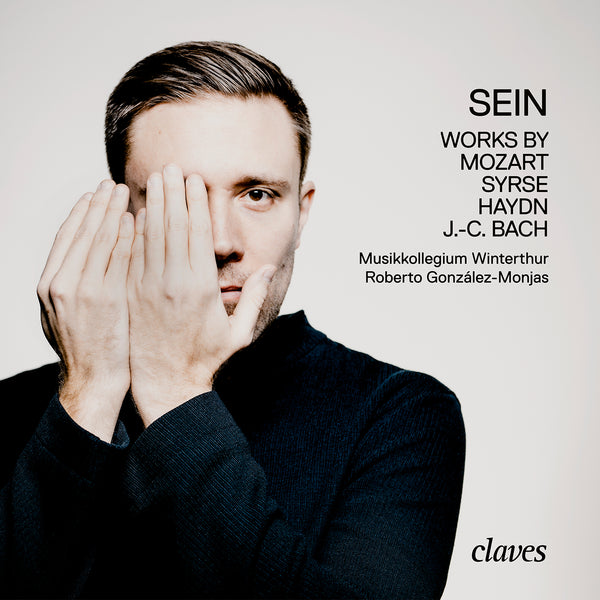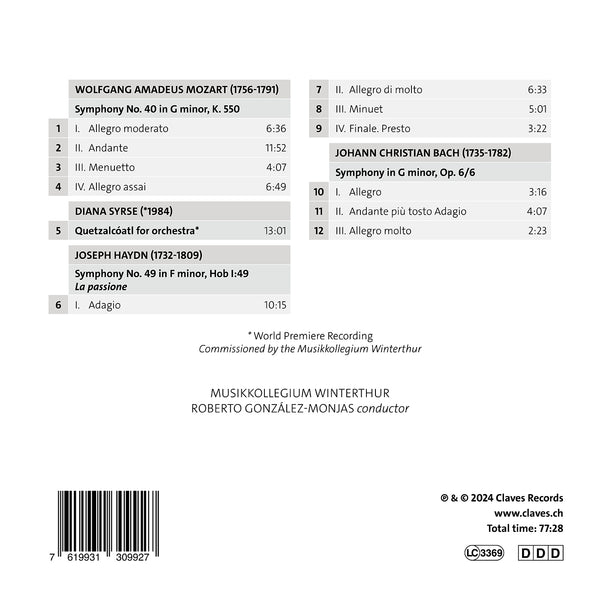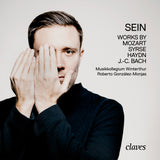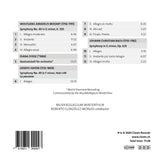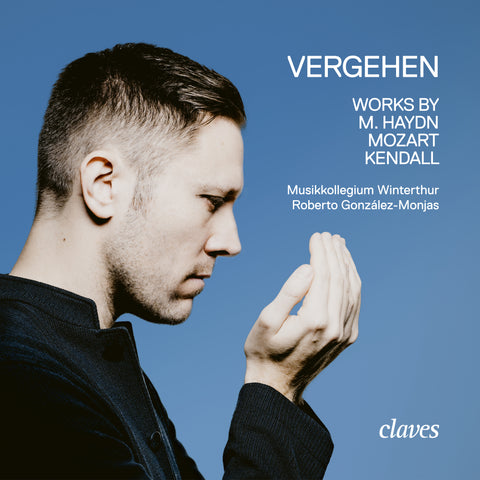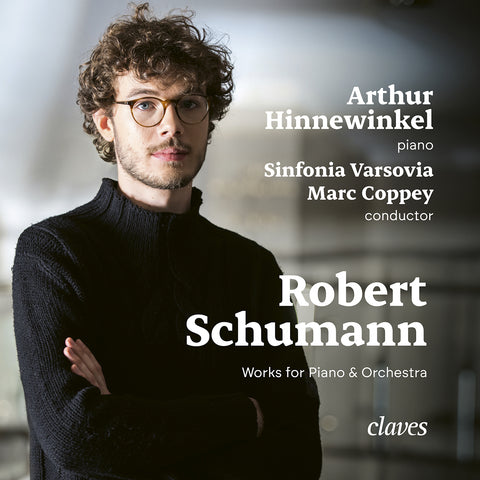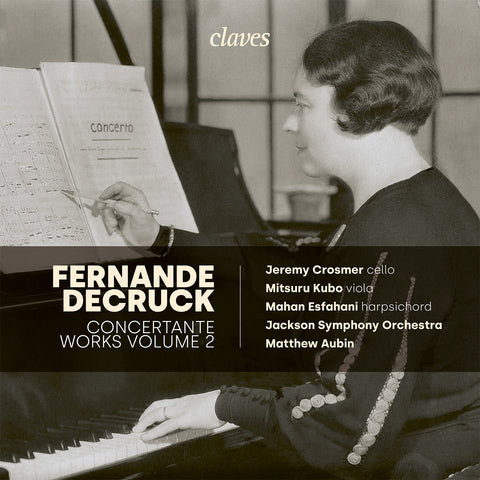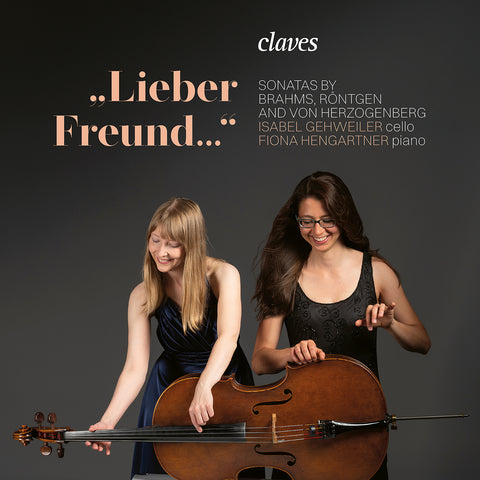(2025) «Sein» works by Mozart - Syrse - Haydn - J.-C. Bach
Category(ies): Modern Orchestra Repertoire
Main Composer: Various composers (see collections)
Orchestra: Musikkollegium Winterthur
Conductor: Roberto González-Monjas
CD set: 1
Catalog N°:
CD 3099
Release: 24.01.2025
EAN/UPC: 7619931309927
This album is now on repressing. Pre-order it at a special price now.
CHF 18.50
This album is no longer available on CD.
This album has not been released yet. Pre-order it from now.
CHF 18.50
This album is no longer available on CD.
CHF 18.50
VAT included for Switzerland & UE
Free shipping
This album is no longer available on CD.
VAT included for Switzerland & UE
Free shipping
This album is now on repressing. Pre-order it at a special price now.
CHF 18.50
This album is no longer available on CD.
This album has not been released yet.
Pre-order it at a special price now.
CHF 18.50
This album is no longer available on CD.
CHF 18.50
This album is no longer available on CD.
«SEIN» WORKS BY MOZART - SYRSE - HAYDN - J.-C. BACH
ROBERTO GONZÁLEZ-MONJAS ON MOZART’S THEATRE OF SUFFERING
The Musikkollegium Winterthur’s Chief Conductor, Roberto González-Monjas, took the three last symphonies that Mozart composed – in rapid succession in the summer of 1788 – as the inspiration for this large-scale seasonal triptych. While the first symphony (No. 39) in E flat major has a slow introduction, the last (No. 41), known as the “Jupiter Symphony”, ends with a breath-taking finale, so that “beginning” and “ending” – yes, let’s say “becoming” and “transcending” – are integral to the artistic concept of this trilogy. The central G minor Symphony (No. 40) stands for “being”: for “being in the centre.”
In fact, we are rarely thrown into a musical maelstrom as abruptly and breathlessly as in this G minor symphony by Mozart. It’s almost as if we notice the first, soft strains of the viola only when the violins make their entrance with their famous melody – and by that time, we have already been thrown into the thick of it. The fact that the melody became a mobile phone ringtone in the 1990s obscures how unusual it actually is: restless, consisting of small elements – “sighs,” as we often read.
The history of a sigh
For his time, the way Mozart uses these sighs is quite audacious. There is an established tradition of the poignant half-step friction between the notes E flat and D flat, between the minor sixth and fifth of the key. In his St Matthew Passion, for example, Johann Sebastian Bach uses minor sixths and fifths in an alto aria to express the words of the text “Buss und Reu.” And Mozart himself also likes to use this musical formula – when Barbarina sings her sorrowful cavatina in Le Nozze di Figaro, for instance. Yet in all these cases, the minor sixth so characteristic of minor keys is merely heard as an evasion; starting from the chordal fifth, it is briefly and expressively touched upon. In his Symphony No. 40, however, Mozart introduces the lugubrious sixth before the fifth is even heard! This, too, is an aspect of “being in the centre.”
This brief digression into the history of this musical formula of pain may make it clear that, in this case, the familiar form of the symphony is already operating with the aesthetic categories of discord and passion favoured by the literary epoch of “Sturm und Drang.” This aesthetic becomes even more striking in the abrupt final movement, which is characterised by caesuras. “Sighs and dissonances, daring modulations and chiaroscuro contrasts” are among the characteristics that Roberto González-Monjas mentions. The choice of G minor is also relevant in this context: in The Magic Flute, Pamina sings her “Ach ich fühl’s, es ist verschwunden” in this key. And Don Giovanni descends to hell in the key of G minor. As far as symphonies go, Mozart’s Symphony No. 40 is the culmination of a series of similarly agitated predecessors, such as Johann Christian Bach’s Symphony in G minor op. 6/6. In comparison, Mozart’s music is more obsessive – for example, in that the sighing figure is incessantly repeated, as if the music were touching a vexatious wound – and at the same time more rational, insofar as it is composed with unrivalled mastery.
Human failings
The fact that, even behind the expressive eccentricity, there is a planned concept reveals Mozart as an artist of the Enlightenment – also here in G minor, and not only in the work’s lighter sister symphonies in the keys of E flat and C major. For Roberto González-Monjas, however, Mozart succeeds in demonstrating this even more comprehensively than rationalist aesthetics – with their ideal of symmetry and perfection – would be capable of doing. Mozart is not afraid of showing “the wrinkles, even ugliness; the small and large failings that make us human.”
Roberto González-Monjas identifies “suffering” as the fundamental idea behind Mozart’s Symphony No. 40. But it is not merely “suffering in today’s parlance of pain and grief, but in the broader context of the 18th century, where everything that happens to us that we are unable to direct or control tends to be referred to in this way. González-Monjas is thinking of the physical – from twitching, dancing feet to carnal sin – and of course the broad field of emotions. It is no coincidence that in Mozart’s century, such sensations were referred to as “passions.”
Swept away in a “storm of passions”
Understood in this way, “suffering” becomes almost synonymous with “being.” And what art is better suited not only to reveal to us all the facets of existence, but also to make us suffer through them? Mozart’s Symphony No. 40 achieves this best when the music – such as the initial, sighing figure – appears in an ever-changing light, in ever-changing guises, as the movements progress. Sometimes surprisingly, sometimes logically. Mozart achieves what Johann Georg Sulzer wrote about listening to music in his Allgemeine Theorie der Schönen Künste (1771): “We feel a storm of passion that sweeps us away – and to which the soul is incapable of resisting.”
Felix Michel
DIANA SYRSE Quetzalcóatl - World Premiere Recording
This work combines two parallel stories that converge in a common experience – Wolfgang Amadeus Mozart, an Austrian, and myself, a Mexican, both of us young composers writing music in different eras. He and I meet in the exploration of music as a means of expressing the profound pain of a lost love and the inner transformation that accompanies it. Inspired by Mozart’s Symphony No. 40 and my own life experiences, I have created this work as a counterpoint and dialogue dedicated to the constant reinvention of beauty. I long for the music to become a path to lead performers and audiences into new emotional realms, immersing them in the intensity of love, pain, passion and freedom, all from the perspective of a composer rooted in Aztec traditions and deities.
The god Quetzalcóatl, who appears in the guise of a feathered serpent, symbolises nature, power, the duality between darkness and light, and liberation – a central element in the musical narrative of this work. So we, Wolfgang and I, who come from different worlds, find ourselves temporarily confronted with the same empty staves, sharing overwhelming grief and passion. I have written this piece as an emotional tribute to my mother, my culture and the power of transformation that leads us to an awareness of universal solidarity.
Diana Syrse
DIANA SYRSE (*1984) dianasyrse.com
Diana Syrse is a composer and singer from Mexico. She is drawn to current, socially relevant topics and also documents her everyday life in musical form. As a musician, she also likes to combine acoustic instruments with electronics, and uses her own voice or pre-Hispanic instruments to create new urban soundscapes. Her oeuvre includes works for choirs, orchestras, ensembles, electronics, electro-acoustic music, dance, opera, and new musical theatre. Syrse’s music has been performed in Europe, Canada, Latin America, the United States, Africa and Asia.
In the realm of opera and theatre, she has worked as composer-in-residence on more than 15 musical theatre and opera productions, and has collaborated with various authors and directors in Germany – at the Kammerspiele München, Schauspiel Frankfurt, Staatsoper Hamburg, Deutsche Oper am Rhein, Neuköllner Oper, Berlin, Staatstheater Braunschweig and the Berliner Ensemble. As a composer and singer, Diana Syrse has worked with the Los Angeles Philharmonic, the Staatsoper Hamburg, VocalEssence, the Babylon Orchestra Berlin, the Trio D’Argent, the Akademie August Everding, the Secession Orchestra in Paris and the Les Chambres aux échos theatre company.
MUSIKKOLLEGIUM WINTERTHUR musikkollegium.ch
The Musikkollegium Winterthur was founded in 1629 and thus boasts one of the longest-standing traditions among Europe’s musical institutions. Winterthur occupies a prominent position in Europe’s cultural landscape. This is due not only to its art collections, but also to its orchestra – the Musikkollegium Winterthur – which has been under the direction of Chief Conductor Roberto González-Monjas since the 2021/22 season. Stretching back to 1629, the history of the Musikkollegium Winterthur is still very much alive: today, the dedication of Winterthur’s bourgeois families of the 17th century is maintained by the numerous members of the orchestra association. The early 20th century was a particularly formative period, with patron of the arts Werner Reinhart and conductor Hermann Scherchen transforming Winterthur into a centre of European musical life. Igor Stravinsky, Richard Strauss and Anton Webern all frequented the city, as did Clara Haskil and Wilhelm Furtwängler. This is a legacy that comes with obligations: no other classical symphony orchestra in Switzerland devotes itself to contemporary music with as much natural confidence as the Musikkollegium Winterthur.
World premières also feature on the programme – most recently of works by composers such as Richard Dubugnon, Helena Winkelman, David Philip Hefti, Matthias Pintscher, Andrea Tarrodi and Arash Safaian. In its remaining repertoire, the orchestra focuses on the classical and early romantic periods. However, the agile ensemble also enjoys shedding fresh light on great symphonic works, such as those by Brahms, who is the subject of a recent CD recording. The orchestra can also be regularly experienced in opera and ballet productions. With more than 40 concerts per season, a versatile musical education programme and interdisciplinary formats, the Musikkollegium Winterthur is an outstanding ensemble. Many artists have contributed to the high quality of the orchestra’s performances: former chief conductors such as Franz Welser-Möst, Heinrich Schiff or Thomas Zehetmair, long-standing guest conductors such as Heinz Holliger, Reinhard Goebel and Michael Sanderling, but also internationally sought-after soloists, who are always pleased to return to the Musikkollegium Winterthur. Andreas Ottensamer, Barbara Hannigan, Sir András Schiff, Ian Bostridge and Carolin Widmann, among others, regularly give guest performances in Winterthur.
ROBERTO GONZÁLEZ-MONJAS
Roberto González-Monjas is an extremely sought-after conductor and violinist who has rapidly established an international reputation. He is Chief Conductor of the Musikkollegium Winterthur, Principal Guest Conductor of the Belgian National Orchestra as well as Chief Conductor of the Orquesta Sinfónica de Galicia in Spain. As of September 2024, he will also be Chief Conductor of the Mozarteumorchester Salzburg. As a committed educator, Roberto González-Monjas founded the Iberacademy together with conductor Alejandro Posada in 2013. The institution aims to create an efficient and sustainable model of musical education in Latin America that focuses on disadvantaged sections of the population – as well as promoting highly talented young musicians. González-Monjas is also Professor of Violin at the Guildhall School of Music & Drama, and regularly mentors and conducts the Guildhall School Chamber and Symphony Orchestra at London’s Barbican Hall. Previously, Roberto González-Monjas held the post of Concertmaster of the Orchestra dell’Accademia Nazionale di Santa Cecilia for six years and was also Concertmaster of the Musikkollegium Winterthur until the end of the 2020/21 season.
REVIEWS
“[..] The program concludes with another G minor symphony, the sixth op. 6/6 by Johann Christian Bach, his darkest and most dramatic. Roberto González-Monjas and the Musikkollegium deliver a wonderfully clear, engaging performance, and their brisk concluding Allegro di molto makes for a particularly impressive and memorable finale.” - Remy Franck, January 2025
ROBERTO GONZÁLEZ-MONJAS ON MOZART’S THEATRE OF SUFFERING
The Musikkollegium Winterthur’s Chief Conductor, Roberto González-Monjas, took the three last symphonies that Mozart composed – in rapid succession in the summer of 1788 – as the inspiration for this large-scale seasonal triptych. While the first symphony (No. 39) in E flat major has a slow introduction, the last (No. 41), known as the “Jupiter Symphony”, ends with a breath-taking finale, so that “beginning” and “ending” – yes, let’s say “becoming” and “transcending” – are integral to the artistic concept of this trilogy. The central G minor Symphony (No. 40) stands for “being”: for “being in the centre.”
In fact, we are rarely thrown into a musical maelstrom as abruptly and breathlessly as in this G minor symphony by Mozart. It’s almost as if we notice the first, soft strains of the viola only when the violins make their entrance with their famous melody – and by that time, we have already been thrown into the thick of it. The fact that the melody became a mobile phone ringtone in the 1990s obscures how unusual it actually is: restless, consisting of small elements – “sighs,” as we often read.
The history of a sigh
For his time, the way Mozart uses these sighs is quite audacious. There is an established tradition of the poignant half-step friction between the notes E flat and D flat, between the minor sixth and fifth of the key. In his St Matthew Passion, for example, Johann Sebastian Bach uses minor sixths and fifths in an alto aria to express the words of the text “Buss und Reu.” And Mozart himself also likes to use this musical formula – when Barbarina sings her sorrowful cavatina in Le Nozze di Figaro, for instance. Yet in all these cases, the minor sixth so characteristic of minor keys is merely heard as an evasion; starting from the chordal fifth, it is briefly and expressively touched upon. In his Symphony No. 40, however, Mozart introduces the lugubrious sixth before the fifth is even heard! This, too, is an aspect of “being in the centre.”
This brief digression into the history of this musical formula of pain may make it clear that, in this case, the familiar form of the symphony is already operating with the aesthetic categories of discord and passion favoured by the literary epoch of “Sturm und Drang.” This aesthetic becomes even more striking in the abrupt final movement, which is characterised by caesuras. “Sighs and dissonances, daring modulations and chiaroscuro contrasts” are among the characteristics that Roberto González-Monjas mentions. The choice of G minor is also relevant in this context: in The Magic Flute, Pamina sings her “Ach ich fühl’s, es ist verschwunden” in this key. And Don Giovanni descends to hell in the key of G minor. As far as symphonies go, Mozart’s Symphony No. 40 is the culmination of a series of similarly agitated predecessors, such as Johann Christian Bach’s Symphony in G minor op. 6/6. In comparison, Mozart’s music is more obsessive – for example, in that the sighing figure is incessantly repeated, as if the music were touching a vexatious wound – and at the same time more rational, insofar as it is composed with unrivalled mastery.
Human failings
The fact that, even behind the expressive eccentricity, there is a planned concept reveals Mozart as an artist of the Enlightenment – also here in G minor, and not only in the work’s lighter sister symphonies in the keys of E flat and C major. For Roberto González-Monjas, however, Mozart succeeds in demonstrating this even more comprehensively than rationalist aesthetics – with their ideal of symmetry and perfection – would be capable of doing. Mozart is not afraid of showing “the wrinkles, even ugliness; the small and large failings that make us human.”
Roberto González-Monjas identifies “suffering” as the fundamental idea behind Mozart’s Symphony No. 40. But it is not merely “suffering in today’s parlance of pain and grief, but in the broader context of the 18th century, where everything that happens to us that we are unable to direct or control tends to be referred to in this way. González-Monjas is thinking of the physical – from twitching, dancing feet to carnal sin – and of course the broad field of emotions. It is no coincidence that in Mozart’s century, such sensations were referred to as “passions.”
Swept away in a “storm of passions”
Understood in this way, “suffering” becomes almost synonymous with “being.” And what art is better suited not only to reveal to us all the facets of existence, but also to make us suffer through them? Mozart’s Symphony No. 40 achieves this best when the music – such as the initial, sighing figure – appears in an ever-changing light, in ever-changing guises, as the movements progress. Sometimes surprisingly, sometimes logically. Mozart achieves what Johann Georg Sulzer wrote about listening to music in his Allgemeine Theorie der Schönen Künste (1771): “We feel a storm of passion that sweeps us away – and to which the soul is incapable of resisting.”
Felix Michel
DIANA SYRSE Quetzalcóatl - World Premiere Recording
This work combines two parallel stories that converge in a common experience – Wolfgang Amadeus Mozart, an Austrian, and myself, a Mexican, both of us young composers writing music in different eras. He and I meet in the exploration of music as a means of expressing the profound pain of a lost love and the inner transformation that accompanies it. Inspired by Mozart’s Symphony No. 40 and my own life experiences, I have created this work as a counterpoint and dialogue dedicated to the constant reinvention of beauty. I long for the music to become a path to lead performers and audiences into new emotional realms, immersing them in the intensity of love, pain, passion and freedom, all from the perspective of a composer rooted in Aztec traditions and deities.
The god Quetzalcóatl, who appears in the guise of a feathered serpent, symbolises nature, power, the duality between darkness and light, and liberation – a central element in the musical narrative of this work. So we, Wolfgang and I, who come from different worlds, find ourselves temporarily confronted with the same empty staves, sharing overwhelming grief and passion. I have written this piece as an emotional tribute to my mother, my culture and the power of transformation that leads us to an awareness of universal solidarity.
Diana Syrse
DIANA SYRSE (*1984) dianasyrse.com
Diana Syrse is a composer and singer from Mexico. She is drawn to current, socially relevant topics and also documents her everyday life in musical form. As a musician, she also likes to combine acoustic instruments with electronics, and uses her own voice or pre-Hispanic instruments to create new urban soundscapes. Her oeuvre includes works for choirs, orchestras, ensembles, electronics, electro-acoustic music, dance, opera, and new musical theatre. Syrse’s music has been performed in Europe, Canada, Latin America, the United States, Africa and Asia.
In the realm of opera and theatre, she has worked as composer-in-residence on more than 15 musical theatre and opera productions, and has collaborated with various authors and directors in Germany – at the Kammerspiele München, Schauspiel Frankfurt, Staatsoper Hamburg, Deutsche Oper am Rhein, Neuköllner Oper, Berlin, Staatstheater Braunschweig and the Berliner Ensemble. As a composer and singer, Diana Syrse has worked with the Los Angeles Philharmonic, the Staatsoper Hamburg, VocalEssence, the Babylon Orchestra Berlin, the Trio D’Argent, the Akademie August Everding, the Secession Orchestra in Paris and the Les Chambres aux échos theatre company.
MUSIKKOLLEGIUM WINTERTHUR musikkollegium.ch
The Musikkollegium Winterthur was founded in 1629 and thus boasts one of the longest-standing traditions among Europe’s musical institutions. Winterthur occupies a prominent position in Europe’s cultural landscape. This is due not only to its art collections, but also to its orchestra – the Musikkollegium Winterthur – which has been under the direction of Chief Conductor Roberto González-Monjas since the 2021/22 season. Stretching back to 1629, the history of the Musikkollegium Winterthur is still very much alive: today, the dedication of Winterthur’s bourgeois families of the 17th century is maintained by the numerous members of the orchestra association. The early 20th century was a particularly formative period, with patron of the arts Werner Reinhart and conductor Hermann Scherchen transforming Winterthur into a centre of European musical life. Igor Stravinsky, Richard Strauss and Anton Webern all frequented the city, as did Clara Haskil and Wilhelm Furtwängler. This is a legacy that comes with obligations: no other classical symphony orchestra in Switzerland devotes itself to contemporary music with as much natural confidence as the Musikkollegium Winterthur.
World premières also feature on the programme – most recently of works by composers such as Richard Dubugnon, Helena Winkelman, David Philip Hefti, Matthias Pintscher, Andrea Tarrodi and Arash Safaian. In its remaining repertoire, the orchestra focuses on the classical and early romantic periods. However, the agile ensemble also enjoys shedding fresh light on great symphonic works, such as those by Brahms, who is the subject of a recent CD recording. The orchestra can also be regularly experienced in opera and ballet productions. With more than 40 concerts per season, a versatile musical education programme and interdisciplinary formats, the Musikkollegium Winterthur is an outstanding ensemble. Many artists have contributed to the high quality of the orchestra’s performances: former chief conductors such as Franz Welser-Möst, Heinrich Schiff or Thomas Zehetmair, long-standing guest conductors such as Heinz Holliger, Reinhard Goebel and Michael Sanderling, but also internationally sought-after soloists, who are always pleased to return to the Musikkollegium Winterthur. Andreas Ottensamer, Barbara Hannigan, Sir András Schiff, Ian Bostridge and Carolin Widmann, among others, regularly give guest performances in Winterthur.
ROBERTO GONZÁLEZ-MONJAS
Roberto González-Monjas is an extremely sought-after conductor and violinist who has rapidly established an international reputation. He is Chief Conductor of the Musikkollegium Winterthur, Principal Guest Conductor of the Belgian National Orchestra as well as Chief Conductor of the Orquesta Sinfónica de Galicia in Spain. As of September 2024, he will also be Chief Conductor of the Mozarteumorchester Salzburg. As a committed educator, Roberto González-Monjas founded the Iberacademy together with conductor Alejandro Posada in 2013. The institution aims to create an efficient and sustainable model of musical education in Latin America that focuses on disadvantaged sections of the population – as well as promoting highly talented young musicians. González-Monjas is also Professor of Violin at the Guildhall School of Music & Drama, and regularly mentors and conducts the Guildhall School Chamber and Symphony Orchestra at London’s Barbican Hall. Previously, Roberto González-Monjas held the post of Concertmaster of the Orchestra dell’Accademia Nazionale di Santa Cecilia for six years and was also Concertmaster of the Musikkollegium Winterthur until the end of the 2020/21 season.
REVIEWS
“[..] The program concludes with another G minor symphony, the sixth op. 6/6 by Johann Christian Bach, his darkest and most dramatic. Roberto González-Monjas and the Musikkollegium deliver a wonderfully clear, engaging performance, and their brisk concluding Allegro di molto makes for a particularly impressive and memorable finale.” - Remy Franck, January 2025
Return to the album | Read the booklet | Composer(s): Various Composers | Main Artist: Roberto González-Monjas
STUDIO MASTER (HIGH-RESOLUTION AUDIO)
High-resolution audio - Studio master quality
In stock
Johann Christian Bach (1735-1782)
Joseph Haydn (1732-1809)
Modern
Musikkollegium Winterthur
New releases
Orchestra
Repertoire
Roberto González-Monjas - conductor
Various composers
Wolfgang Amadeus Mozart (1756-1791)
World Premiere Recording
High-resolution audio - Studio master quality
In stock
Johann Christian Bach (1735-1782)
Joseph Haydn (1732-1809)
Modern
Musikkollegium Winterthur
New releases
Orchestra
Repertoire
Roberto González-Monjas - conductor
Various composers
Wolfgang Amadeus Mozart (1756-1791)
World Premiere Recording






